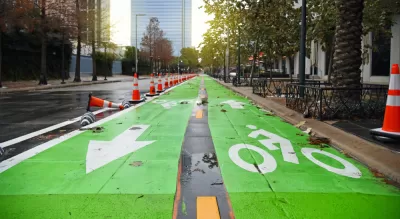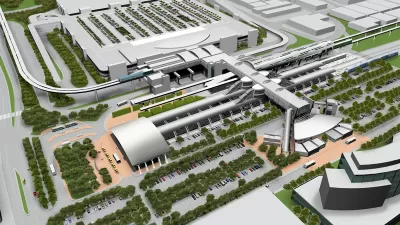A fitness tracking app reports dramatic increases in bike ridership since the onset of the coronavirus pandemic.

Fitness tracking app Strava is recording year-over-year surges in bike ridership since COVID-19 lockdown with impressive accuracy.
The cities with the greatest reported increase in bike ridership aren't the cycle gear-clad cities typically making waves in the bike world. "Houston and Los Angeles, two sprawling metropolises where just .5% and 1% of the respective populations biked to work in pre-pandemic times, stand out. In Houston, the total volume of cycling trips in Houston was 138% higher in May 2020 than in May 2019. In Los Angeles, the jump was 93%," writes Laura Bliss.
Strava's 68 million global users are telling a digital, data-laden story of increased bike usage consistent with research by the U.S. Centers for Disease Control. Even cycling experts and advocates confirm that "Strava numbers are consistent with data from local bike-counters and bike-share systems," Bliss reports.
Bliss notes one city notably missing from the list of cities with ridership increases: Portland. Despite a reputation for bike-friendliness, Portland saw year-over-year declines in bike ridership. There is speculation that protests or the canceled Seattle-to-Portland bike ride could be the cause of the drop, according to Bliss.
"Washington, D.C. also did not see the kind of surge that other cities did," says Bliss. Both Portland and Washington, D.C.'s drop could be explained by an already high level of bike commutes reduced by shelter-in-place mandates.
For the cities that did see an increase in ridership, the question is now how to keep community members on bikes, says L.A. County Bicycle Coalition executive director Eli Akira Kaufman.
FULL STORY: The Pandemic Bike Boom Hits in Some Unexpected American Cities

Alabama: Trump Terminates Settlements for Black Communities Harmed By Raw Sewage
Trump deemed the landmark civil rights agreement “illegal DEI and environmental justice policy.”

Planetizen Federal Action Tracker
A weekly monitor of how Trump’s orders and actions are impacting planners and planning in America.

The 120 Year Old Tiny Home Villages That Sheltered San Francisco’s Earthquake Refugees
More than a century ago, San Francisco mobilized to house thousands of residents displaced by the 1906 earthquake. Could their strategy offer a model for the present?

In Both Crashes and Crime, Public Transportation is Far Safer than Driving
Contrary to popular assumptions, public transportation has far lower crash and crime rates than automobile travel. For safer communities, improve and encourage transit travel.

Report: Zoning Reforms Should Complement Nashville’s Ambitious Transit Plan
Without reform, restrictive zoning codes will limit the impact of the city’s planned transit expansion and could exclude some of the residents who depend on transit the most.

Judge Orders Release of Frozen IRA, IIJA Funding
The decision is a victory for environmental groups who charged that freezing funds for critical infrastructure and disaster response programs caused “real and irreparable harm” to communities.
Urban Design for Planners 1: Software Tools
This six-course series explores essential urban design concepts using open source software and equips planners with the tools they need to participate fully in the urban design process.
Planning for Universal Design
Learn the tools for implementing Universal Design in planning regulations.
Clanton & Associates, Inc.
Jessamine County Fiscal Court
Institute for Housing and Urban Development Studies (IHS)
City of Grandview
Harvard GSD Executive Education
Toledo-Lucas County Plan Commissions
Salt Lake City
NYU Wagner Graduate School of Public Service





























